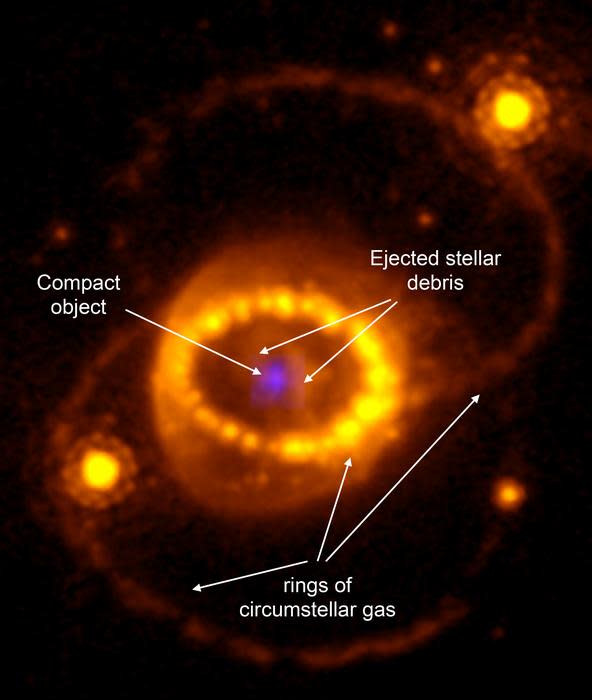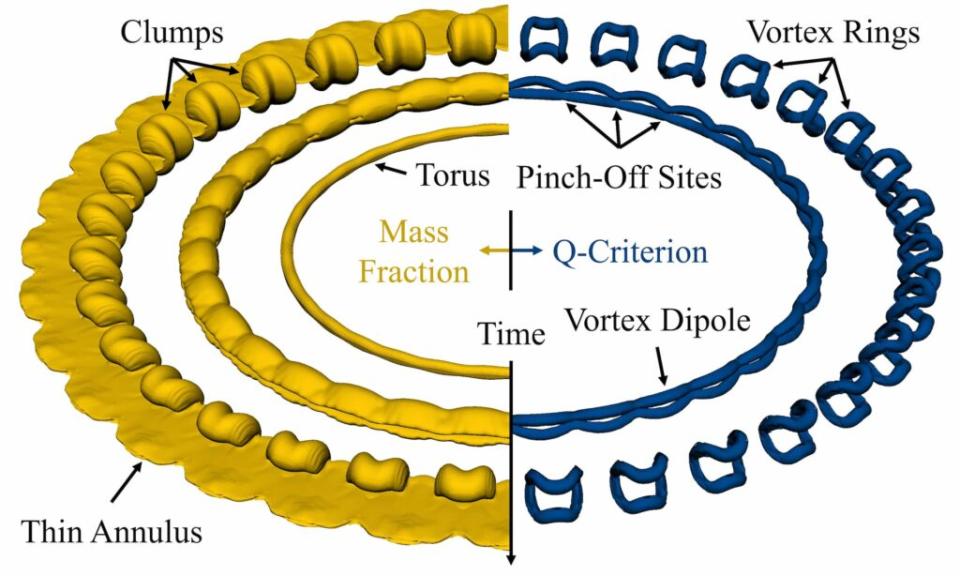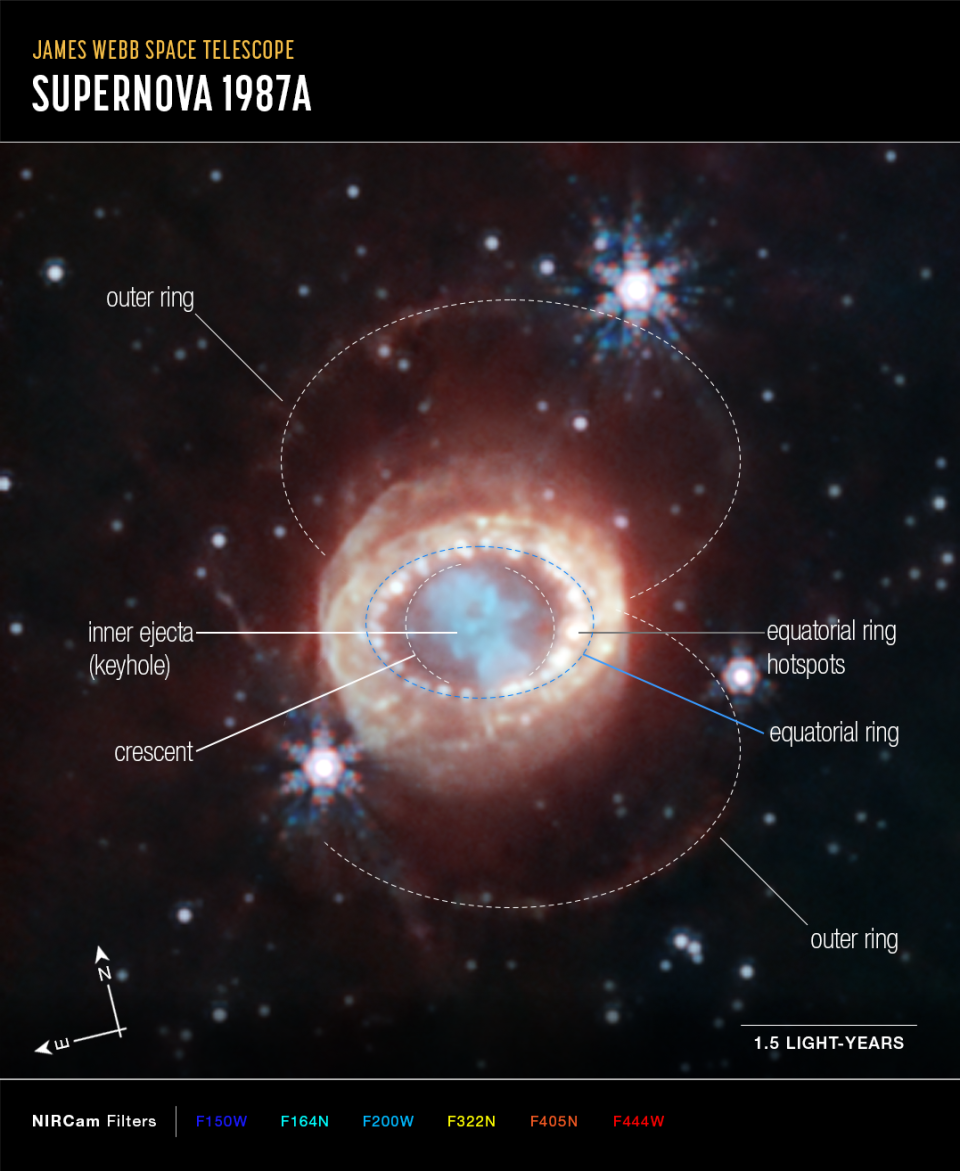Scientists may have discovered how a supernova relatively close to Earth was adorned with a remarkable “string of pearls” formation.
Supernova 1987A (SN 1987A) represents the remnants of a massive cosmic explosion that ripped apart a massive star and left behind a neutron star surrounded by stellar material. It is located in a satellite galaxy of the Milky Way called the Large Magellanic Cloud, or LMC. This region is approximately 160,000 light years away from us.
What’s particularly striking about SN 1987A is that it is surrounded by clumps of glowing hydrogen plasma, a structure that has become a long-standing mystery in astrophysics. A phenomenon called Rayleigh-Taylor instability is often used to explain the formation of fluid structures in plasma like what we see around SN 1987A, but this concept alone cannot fully explain the supernova remnant’s cosmic jewels.
But now researchers from the University of Michigan may finally understand how this “string of pearls” was forged. They believe the structure may be linked to the way contrails are created. These are the fluffy white lines left behind in the sky by planes as they fly over the Earth’s surface.
Relating to: James Webb Space Telescope detects neutron star hiding in supernova debris
Michael Wadas, a team member and researcher from the California Institute of Technology, said in a statement: “The same mechanism that breaks aircraft rudders may be at work here.”
The team proposes that the formation of hydrogen clusters of SN1987A with this parallel plane may be the result of a mechanism called “Crow instability”. On closer inspection, this phenomenon occurs when airflow from each wing of a jet spirals into each other, known as wingtip vortices. This creates gaps in what would normally be smooth cloud lines, visible due to water vapor in the jet’s exhaust.
Crow instability can also do something Rayleigh-Taylor couldn’t: Help researchers predict the number of clusters that should be seen around the supernova remnant.
“The Rayleigh-Taylor instability might tell you that there might be clusters, but it would be very difficult to put a number on that,” Wadas said.
Dress like a superstar supernova
SN 1987A’s proximity to Earth is just part of what makes it one of the most famous and best-studied supernovae.
Moreover, this cosmic explosion occurred at a time when its light could reach the Earth, at a time when humanity was equipped with the necessary tools to monitor its own evolution. In fact, SN 1987A was the first supernova visible to the naked eye since Kepler’s supernova was seen in 1604. All this makes SN 1987A an incredibly rare astrophysical event with enormous impact on our understanding of the evolution and eventual death of stars.
Supernovae, such as SN 1987A, occur when massive stars exhaust the fuel resources required for nuclear fusion in their cores. This causes the star’s core to contract rapidly, creating a shock wave that creates a powerful explosion or supernova that blows out the outer layers of the dying star. This stellar core turns into either a neutron star or a black hole, depending on its mass.

Scientists still don’t know a bit about the star that died to leave behind debris they call SN 1987A. In fact, it was only this year that we were able to detect that a neutron star actually exists at the heart of SN 1987A, thanks to observations with the James Webb Space Telescope (JWST).
However, scientists suggest that a ring of gas surrounding the star and exploding to form SN 1987A was formed by the merger of two stars. This collision may have caused hydrogen to break away from the two stars, allowing the element to escape into space as the merger fostered a blue supergiant star.
This must have happened tens of thousands of years before the supernova. In the interim before this stellar explosion, strong stellar winds of high-speed charged particles emitted from the star must have blown away this gas. This may have created hydrogen clusters around the star before it went supernova; This means that the string of pearls adorning SN 1987A may have been there before the supernova occurred.


To confirm this origin story, the University of Michigan team created a complex simulation of the cloud being pushed outward by the stellar wind as the flow of particles exerts a type of drag force on the cloud.
This resulted in the top and bottom of the gas cloud being pushed farther and faster out of its central region. The cloud folded in on itself, and this behavior triggered what is called Crow instability. This caused the cloud to break up into equal clusters; Pearls that SN 1987A now wears.
The team’s simulation specifically predicted that SN 1987A should be adorned with 32 pearls; This number is pleasingly close to the 30 hydrogen clusters seen around this supernova debris from actual observations.
“That’s a big part of why we think this is Crow instability,” Eric Johnsen, the study’s lead author and a University of Michigan scientist, said in a statement.


The team’s simulation also predicted that Crow instability may have actually created more strings of hydrogen pearls around SN 1987A that are fainter than the first cosmic necklace.
This is something that appears to emerge in the JWST image of supernova debris taken in August 2023. This suggests that the famous supernova may have been adorned with even more cosmic trappings than astronomers can currently see.
Related Stories:
— James Webb Space Telescope captures stunning view of supernova’s expanding remnants (photos)
— SETI searches for alien signals synchronized with supernova 1987A
— A nearby supernova could reveal the secret lives of ghostly neutrinos. Here’s how.
Studying these hydrogen beads could also help scientists determine whether Crow instability occurs when planets form in the collapsing clouds of gas and dust found around baby stars.
The team’s research was published March 13 in the journal Physical Review Letters.